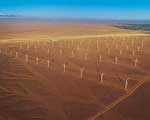China steps up efforts to cut emissions
(Xinhua)
2010-10-18 09
|
|
BEIJING - With a growing multitude of smokestacks dismantled and polluting factories closed, China is scaling up its often painful efforts to curb greenhouse gas emissions and boost energy efficiency.
The Chinese government is currently deliberating the 12th Five-Year Plan for China's development from 2011-2015, a critical period for the country to meet its target set last year to reduce carbon dioxide (CO2) emissions per GDP unit by 40-45 percent by 2020 from the level of 2005.
"It's not easy to achieve it," Barbara Finamore, a senior member of the US-based environmental group National Resources Defense Council (NRDC), said earlier this month in the Chinese city of Tianjin on the sidelines of the latest round of UN climate change talks.
China has successfully slowed down its CO2 emissions growth in the past five years, but without continued efforts to improve energy efficiency and diversify its energy structure, it would only be able to reduce carbon intensity by 37 percent by 2020 from the 2005 level, added Finamore, director of the NRDC's China program.
Striking a similar tone, Fatih Birol, chief economist of the International Energy Agency (IEA), said China's development in the next five years will be crucial for meeting the challenges in energy and the environment.
Their cautious comments resonated with those of many Chinese experts and officials who note that after picking the low-hanging fruit in the initial stage, emission-cutting efforts will become inceasingly difficult in later phases.
In order to deploy the green technologies needed to achieve substantial improvements, China needs to make an additional investment of 1.9 trillion to 3.4 trillion yuan ($285.7 billion to $511.3 billion) in the 12th Five Year Plan period, up from the 1.5 trillion yuan during the previous five years, according to a report released by McKinsey & Company, a global management-consulting firm.
Further complicating the picture is the fact that China, the largest developing country in the world, is in the middle of rapid industrialization and urbanization, and also faces a host of other challenging tasks -- from developing the economy to eliminating poverty and improving people's livelihoods.
China has encountered a whole load of environmental problems that have cropped up in the short space of a mere 30-odd years of rapid economic development, while the industrialized countries had coped with similar problems that accumulated during a span of more than 200 years of industrialization and were solved in a step-by-step manner, noted Xie Zhenhua, vice minister of the National Development and Reform Commission.
Even against such a backdrop, China will not follow in the footsteps of some developed countries whose greenhouse gas emissions are still rising while their per capita GDP has already exceeded $40,000 per year, Xie said.
The Chinese government started to address the CO2 emissions issue with concrete moves when the country's per capita GDP was only around $3,000, he stressed.
Beijing will realize its green targets even if the emission cutting endeavors would reduce the growth rate of China's GDP, Chinese Premier Wen Jiabao said firmly at the Summer Davos forum in September in Tianjin.
China's immense green efforts and firm resolve have also been lauded by many in developed countries. "While America's Republicans turned 'climate change' into a four-letter word - JOKE, China's Communists also turned it into a four-letter word - JOBS," Thomas L. Friedman, a columnist for The New York Times and author of the book "The World is Flat," wrote in a recent article.
In 2009, China surpassed the United States as the country with the largest investments in clean energy, according to the 2010 Global Trends in Sustainable Energy Investment report released by the UN Environment Programme.
The report noted that last year, China saw its private and public investment in key clean energy fields, namely new reneable energy, biofuels and energy efficiency, leap 53 percent from the previous year, and its renewable energy generation capacity increase by 37 GW.
In many ways, China is doing exactly what a properly governed developing country should do, said Johathan Holslag, head of research at the Brussels Institute of Contemporary China Studies.
The Asian country is trying to "lift its people out of poverty while trying to reduce the negative effects of industrialization," Holslag said."Thus far, it has performed this balancing act remarkably well."
"It has invested massively in improving the efficiency of its economy and has committed to reducing the energy intensity of its industrial production to a level that could herald a new stage of green growth," the expert added.
In its march toward a low-carbon economy, China has made it a state priority to build an ecological civilization and has put in place an accountibility system in its emissions-cutting undertaking.
In many important fields, China's efforts to deal with climate change are exemplary and there is much the United States and many other countries can learn from, said Finamore with the NRDC.










